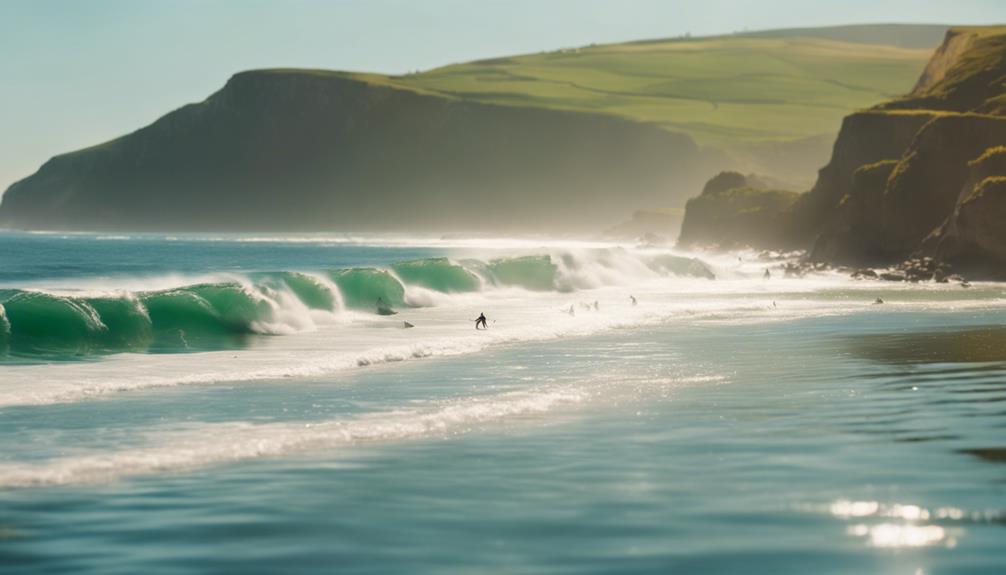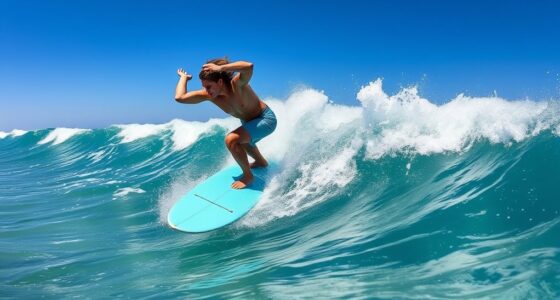Surfing waves are nature's dynamic artwork, formed through the interaction of wind and water. As wind generates friction on the ocean's surface, it creates initial ripples known as capillary waves. With continued wind, these evolve into larger gravity waves. The size and power of waves depend on wind strength, fetch distance, and storm conditions. Waves can be chaotic like windswell or organized like groundswell, each offering unique surfing experiences. You'll find the ocean's complexities fascinating, especially as you explore how these elements work together to create the perfect wave for riding.
Key Takeaways
- Wind creates initial ripples on the ocean surface, evolving into larger gravity waves through continued action and energy transfer.
- Wave characteristics vary, with groundswell providing organized, powerful rides preferred by surfers, while windswell offers chaotic, unpredictable conditions.
- Wave energy is influenced by wind strength, fetch distance and duration, with longer fetches yielding more consistent, well-formed waves.
- Upon reaching the shore, waves release energy that shapes coastlines and supports coastal ecosystems, while also posing hazards like rip currents.
Understanding Wave Formation
Understanding how waves form starts with recognizing that wind blowing across the ocean's surface creates friction, leading to the initial ripples known as capillary waves. These tiny waves signal the beginning of wave energy transfer from the wind to the water.
As the wind continues to blow, these capillary waves can grow into larger gravity waves, where gravity takes over as the dominant force.
The height and power of these waves depend on several factors: the strength of the wind, how long it blows, and the fetch distance, which is the distance over water that the wind travels. Stronger winds over larger areas for extended periods produce the largest waves, maximizing wave energy.
While capillary waves initially limit energy transfer due to surface tension, as the waves grow, they become more capable of carrying energy across great distances.
You'll notice that waves formed closer to shore can be chaotic and unorganized, while those generated far out at sea are typically more powerful and consistent. Recognizing these differences helps you appreciate the intricate processes behind wave formation, setting the stage for understanding their behavior.
Energy Transfer in Waves

When you look at waves, you're witnessing the fascinating transfer of energy from wind to water.
This energy doesn't just vanish; it follows the principles of conservation, moving through the ocean until it reaches the shore.
As waves approach the coastline, you'll notice how their energy disperses, shaping the surf conditions you love.
Energy Conservation Principles
Waves form as wind transfers energy to the water's surface, allowing that energy to travel through the ocean while keeping the water itself mostly still. This transfer of energy follows the Law of Conservation of Energy, which states that energy can't be created or destroyed, only transferred.
As waves propagate across the ocean, they carry energy away from their originating source. When these waves reach the shore, they disperse that energy, often resulting in the dramatic crashing of waves.
The energy carried by a wave depends on several factors, including wind strength and duration. Stronger winds and longer blowing times create waves with greater potential energy, which translates into height. This means that the maximum theoretical height of waves is determined by the conditions that existed when they formed.
You might notice that waves become better organized as they travel longer distances from their storm-generating source. This organization is a result of energy distribution, where the energy remains consistent, yet is shaped by the interaction of waves as they journey across the ocean.
Understanding these energy conservation principles helps you appreciate the beauty and dynamics of surfing waves.
Wave Propagation Mechanism
The energy transfer in waves occurs as they propagate through the ocean, demonstrating how wind-generated forces shape their movement and structure.
Initially, when the wind blows across the water's surface, it creates tiny ripples known as capillary waves. These small waves form as energy is transferred from the wind to the water, initiating a process that can lead to larger waves over time.
As the wind continues to blow, these capillary waves evolve into larger gravity waves, driven by the sustained energy input from the wind. You can think of this energy transfer like ripples spreading out from a stone thrown into a calm lake; the water moves in a circular motion while the overall water body remains largely in place.
The energy travels through the water, influencing wave height and organization based on factors like wind speed, duration, and fetch distance.
Fundamentally, the further the waves travel from the storm that generated them, the more powerful and organized they become. This dynamic process illustrates the fascinating interplay between wind and water, resulting in the breathtaking waves we love to surf.
Shoreline Energy Dispersion
As waves approach the shore, they release energy, causing them to break and create dynamic interactions with the beach and coastal ecosystems. This shoreline energy dispersion is essential for maintaining the balance of these environments. When waves crash onto the land, they don't just vanish; they transfer energy that shapes the coastline and influences life both above and below the water.
Consider what happens during this process:
- The sound of crashing waves can evoke feelings of peace and excitement.
- You witness the power of nature as waves sculpt the sand and rock formations.
- The thrill of surfing is born from the energy released by these waves.
- Coastal ecosystems thrive due to the nutrients brought in by breaking waves.
Understanding shoreline energy dispersion helps you appreciate the intricate dance between waves and the shore.
Every wave carries a story, and as they break, they weave those tales into the fabric of our coastlines, enriching both the environment and our experiences.
Types of Surfing Waves
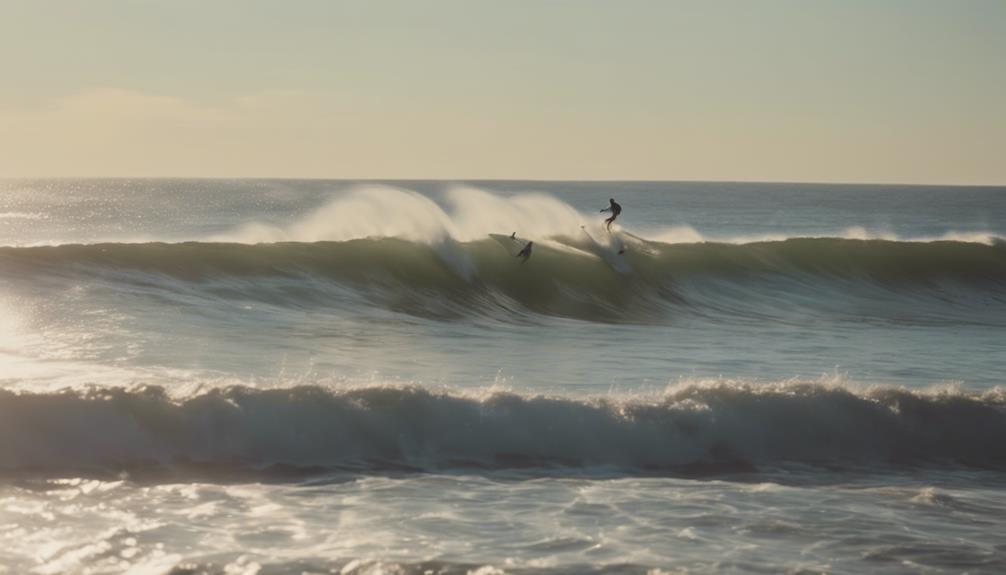
When you're out on the water, understanding the types of surfing waves can make all the difference.
Windswell brings chaotic, short-period waves that can be unpredictable, while groundswell offers the well-formed, powerful waves you often seek.
Windswell Characteristics
Windswell, generated by localized winds near the shore, creates unpredictable and often choppy waves that can challenge even experienced surfers. Unlike the smooth, powerful groundswell, windswell tends to be short-lived and chaotic, making each session a unique experience. The inconsistency of these waves can evoke a mix of thrill and frustration.
When you tackle windswell, you might encounter:
- Bumpy surfaces that require quick adjustments
- Shorter wavelength waves that can catch you off guard
- Choppy conditions that test your balance and skill
- Varying wave heights influenced by shifting winds
While windswell doesn't deliver the reliability of groundswell, it still offers opportunities for adventure. If you're willing to embrace the unpredictability, you might just find that these challenging waves can sharpen your surfing skills.
Groundswell Benefits
Groundswell waves deliver a thrilling and reliable surfing experience, thanks to their powerful energy and well-organized structure that surfers crave. Unlike chaotic windswell, groundswell offers consistently spaced and structured waves, making them the preferred choice for surfers seeking ideal conditions.
Generated far from the coast, these waves travel long distances, allowing them to develop their shape and energy before reaching the beach. The energy of groundswell waves can traverse thousands of miles across oceans, resulting in significant wave heights when they arrive at your favorite surf spot.
This means when you catch a groundswell, you're likely to enjoy larger, more powerful waves that enhance your ride. Additionally, the longer wave periods associated with groundswell contribute to increased maximum wave heights, making these waves even more favorable for surfing.
On groundswell days, surfers flock to the water, knowing they'll encounter organized and predictable waves. This reliability stands in stark contrast to the unpredictable nature of unorganized waves generated closer to shore.
Wave Behavior Dynamics
Surfing waves can be categorized into various types, each exhibiting unique behaviors and characteristics that influence the surfing experience. Understanding these types helps you choose the right conditions for your ride.
- Windswell: These waves are often chaotic, influenced by local wind patterns.
- Groundswell: Well-organized waves that travel long distances, providing powerful rides.
- Capillary waves: Small ripples on the surface, caused by light winds, but they can evolve into larger waves.
- Storm waves: Tall and narrow, they form quickly and can produce instability and whitecaps.
The fetch distance plays a crucial role in wave formation. Longer fetches result in better wave organization, enhancing your surfing experience.
Remember, during storms, wave height increases faster than wave period, leading to those dramatic, steep waves.
Whether you prefer the unpredictability of windswell or the consistency of groundswell, each wave type offers its own thrill. Embrace the dynamics of wave behavior, and you'll find the perfect surf for your next adventure!
Factors Affecting Wave Size

The size of ocean waves is substantially shaped by wind strength, with more powerful gusts creating larger, more energetic swells.
When you think about wave formation, consider how the duration of wind exposure—known as fetch—affects their size. The longer the wind blows over the water, the greater the potential for waves to grow in height. Fetch distance refers to the uninterrupted stretch of water that the wind travels across, and it directly influences wave organization and size.
When fetch is extensive, waves can build up more energy, resulting in powerful swells. For instance, during hurricanes, the winds can exceed 20-30 feet due to their vast fetch and high speeds. You'll notice that as storm conditions develop, wave height often increases more quickly than wave period, leading to the formation of tall and potentially unstable waves.
Understanding these factors helps you appreciate the dynamics behind the waves you ride. So next time you're waiting for that perfect wave, remember that wind strength and fetch are essential in shaping your surfing experience!
The Role of Wind
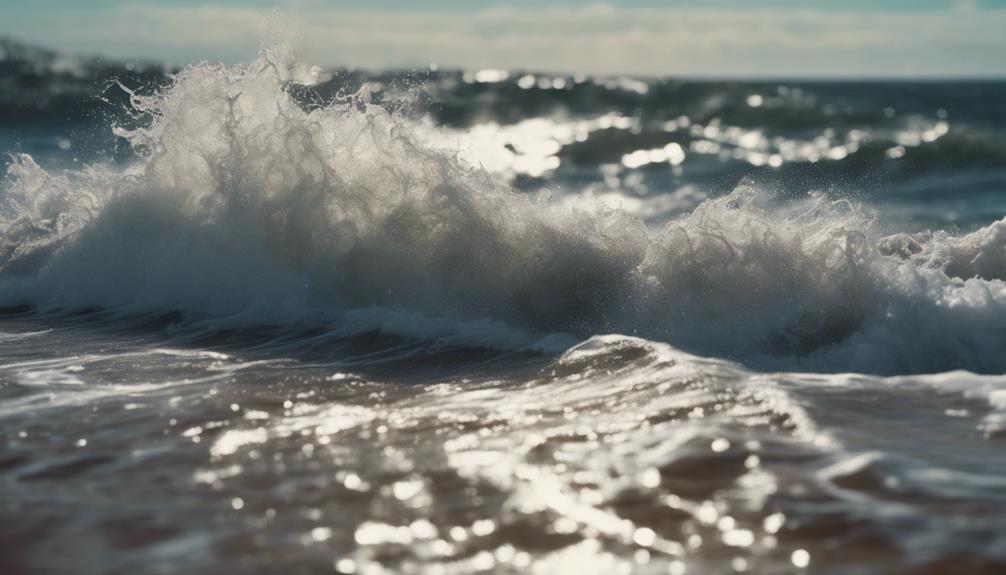
When you think about waves, wind energy is where it all starts.
As the wind transfers its energy to the ocean surface, you see those small capillary waves grow into larger gravity waves.
The distance the wind travels, or fetch, plays a vital role in determining how big those waves can get.
Wind Energy Transfer
Wind energy transfer kicks off with air pressure fluctuations and shear forces as gusts sweep across the water's surface, creating tiny ripples known as capillary waves.
These delicate waves, driven by the wind, are just the beginning of a fascinating transformation. As the wind continues to blow, they can grow into larger waves, depending on various factors.
Consider the thrilling power of wind energy transfer:
- The rush of wind over the ocean ignites a dance of movement.
- Capillary waves ripple out, whispering secrets of the sea.
- Strong winds can give birth to waves that reach monumental heights.
- Each gust carries the promise of adventure for surfers.
The strength and duration of the wind, along with the fetch distance, play essential roles in determining the wave's size and energy.
As the wind picks up speed, it transfers more energy to the water, resulting in larger waves.
Capillary to Gravity Waves
As capillary waves evolve, the ongoing influence of wind transforms them into larger gravity waves, where gravity takes charge in shaping their size and movement.
Initially, capillary waves are just tiny ripples, barely a few millimeters high, created by the wind's friction against the water surface. However, as the wind continues to blow, these small waves gain energy and height, converting into gravity waves.
This transformation relies heavily on sustained wind energy. The longer and stronger the wind blows, the larger the waves can grow. Wind direction also plays a critical role; it creates air pressure differences that enhance the waves' height and stability.
Fundamentally, as capillary waves increase in size, they attract even more wind energy, allowing them to expand further.
In extreme conditions, like storms with wind speeds exceeding 200 km/h, the potential for wave growth skyrockets. The combination of a vast fetch area and prolonged wind duration leads to impressive wave heights.
Understanding this dynamic from capillary waves to gravity waves gives you insight into the forces that create the stunning surf you enjoy while riding the waves.
Fetch Distance Importance
Understanding fetch distance is essential since it directly impacts the size and energy of the waves you encounter while surfing. The longer the fetch distance, the more powerful and organized the waves become. When wind blows across a vast expanse of water, it generates waves that can transform your surfing experience. Here's why fetch distance matters:
- Bigger Waves: Longer fetches lead to larger waves that can provide thrilling rides.
- Consistent Swells: The energy of ground swells can travel thousands of miles, ensuring good surf even at distant beaches.
- Smooth Rides: Waves exiting the fetch area evolve into smoother ground swells, perfect for carving.
- Hurricane Power: Consider how hurricanes, with their extensive fetch distances, produce massive waves that challenge even the most skilled surfers.
Transition From Capillary to Gravity Waves

The initial ripples of capillary waves quickly transform into larger gravity waves as energy from the wind intensifies. As the wind continues to blow, the small capillary waves evolve, driven by the increasing energy. Gravity becomes the dominant force, greatly affecting the wave's behavior and height.
Wind direction and pressure differences play an important role in this shift, leading to substantial wave height increases. Larger gravity waves can attract even more wind energy, which further enhances their size. The maximum wave heights you experience are determined by the wind conditions and the duration of storms.
Here's a quick comparison to help illustrate the shift:
| Wave Type | Characteristics |
|---|---|
| Capillary Waves | Small ripples, few millimeters high |
| Gravity Waves | Larger waves, can reach several meters |
| Energy Source | Wind energy |
| Dominant Force | Gravity |
| Wave Growth | Enhanced by wind fetch and duration |
Understanding this shift is essential as it sets the stage for the powerful gravity waves that surfers seek.
Characteristics of Surfable Waves

Surfable waves depend heavily on wind speed, fetch distance, and wave period, all of which contribute to their size and power. When you're out there riding a wave, you can feel how these factors transform the ocean into a playground.
- The thrill of catching a perfectly formed wave
- The rush of energy as you glide across the water
- The harmony of nature providing the ultimate ride
- The camaraderie with fellow surfers around you
Waves start as capillary waves, but as wind speed increases and fetch distance extends, they evolve into powerful surfable waves. Especially during storms, you'll notice how quickly wave height can rise, often surpassing typical expectations.
Longer wave periods lead to even bigger waves, harnessing energy from the wind over vast distances. Groundswell waves, which can travel thousands of miles, are usually the most thrilling because they arrive with an organized structure and immense power.
Understanding these characteristics will enhance your surfing experience and appreciation for nature's masterpiece. So, next time you're out, remember how each wave you ride is shaped by the elements!
Historical Insights on Surfing

Tracing back through history, surfers have long relied on their knowledge of wave formation and ocean conditions to choose the best spots and times for riding waves. Before modern technology, you'd observe natural indicators like wind direction and tide patterns to predict when the waves would be just right. Early surfers understood the significance of different types of waves, including those known as capillary waves, which are small, rippling disturbances on the water's surface.
As surfing culture flourished in the mid-20th century, the scientific understanding of wave dynamics grew alongside it. This surge in interest led to advancements in surfboard design and techniques, enhancing your overall riding experience.
Even though today's surfers often lean on forecasting websites and live webcams for information, having a solid grasp of historical wave dynamics is still essential. The lessons of the past enrich your connection to the ocean, helping you appreciate the natural beauty of surfing.
The Impact of Fetch Distance

Understanding how fetch distance affects wave formation can greatly enhance your ability to predict surf conditions and choose the best times to hit the water. Fetch distance refers to the uninterrupted stretch of water over which the wind blows, impacting the size and shape of the waves you ride.
Longer fetch distances allow for consistent wind energy, creating well-formed waves that can travel vast distances. You'll notice that these waves tend to be larger and more organized, making your surfing experience more enjoyable. In contrast, shorter fetch distances lead to choppy conditions, which can be frustrating.
Consider the emotions tied to different wave conditions:
- The thrill of riding smooth, large groundswell waves
- The disappointment of choppy, disorganized windswell
- The excitement of chasing powerful surf from distant storms
- The satisfaction of catching a perfectly formed wave
Wave Behavior During Storms
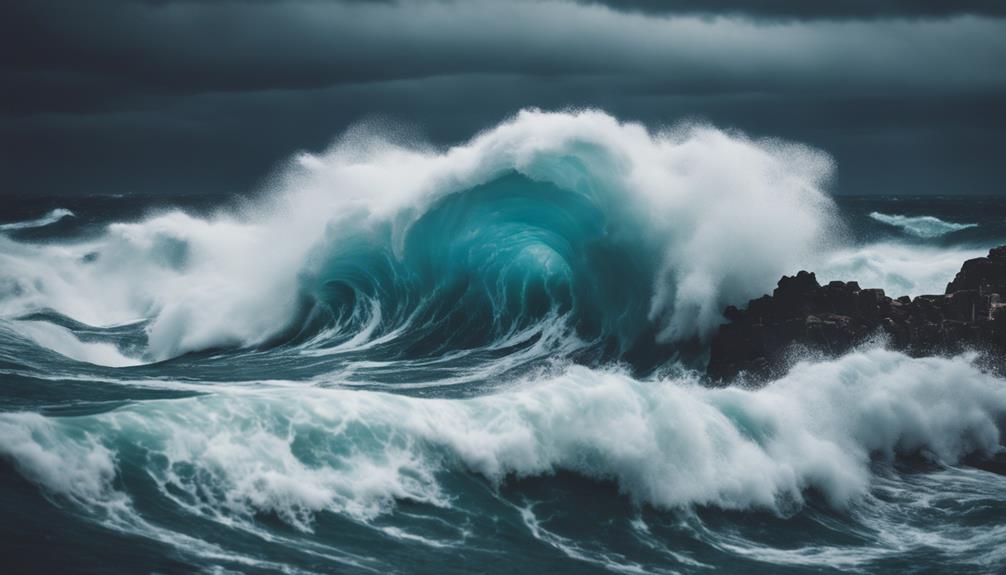
During storms, the sheer power of the wind transforms the ocean's surface, leading to the formation of massive, chaotic waves that can challenge even the most experienced surfers. As strong winds whip across vast fetch areas, waves are created with incredible height and energy. In a hurricane, with an average diameter of about 500 km, wind speeds can exceed 200 km/h, generating exceptionally high waves.
You'll notice that wave height increases more rapidly than wave period during storm conditions. This results in tall, narrow waves that often become unstable, forming white caps as they break. The longer wave periods you encounter correlate with greater maximum wave heights, as the additional energy allows waves to move faster, often outpacing the original wind speed.
When waves exit the chaotic fetch area, they shift from windswell to organized groundswell. This change allows them to travel thousands of miles across the ocean toward shore, making their way to your favorite surfing spots.
Understanding how waves behave during storms can help you better prepare for the challenges and thrills that come with riding these powerful forces of nature.
Frequently Asked Questions
How Are Surfing Waves Formed?
You'll find surfing waves form when wind blows over the ocean, creating ripples that develop into larger waves. Factors like wind strength and duration play a key role in shaping these waves for your enjoyment.
How Are Waves Created in Nature?
Have you ever wondered what creates those mesmerizing waves? It's the wind's dance across the ocean's surface, generating friction that transforms tiny ripples into powerful waves, influenced by speed, duration, and fetch.
Why Are the Waves so Big in Nazare Portugal?
The waves in Nazaré are massive because the underwater canyon funnels swells, strong North Atlantic storms generate powerful groundswell, and the unique geography enhances wave steepness, making it a prime spot for big wave surfing.
What Causes Huge Surfing Waves?
You might think huge surfing waves come from just any wind, but it's really strong winds over large water areas. These winds create powerful energy, especially during storms, leading to those massive, exhilarating waves you crave.
What Factors Contribute to the Formation of Surfing Waves?
Surfing waves and surf science are influenced by several key factors. The most critical is the wind, which generates waves as it blows across the ocean’s surface. The size and shape of the ocean floor also play a role, affecting how waves form and break. Tide and swell direction also contribute.
Conclusion
In the dance of nature, waves rise and fall like a mesmerizing ballet, bringing adventure to the shores.
You've seen how energy transforms into powerful surf, sculpted by the wind and shaped by the ocean's depths.
Understanding these elements not only deepens your appreciation for surfing but also connects you to the heartbeat of the sea.
So, grab your board and ride the crest of each wave, experiencing firsthand the beauty of nature's masterpiece.

